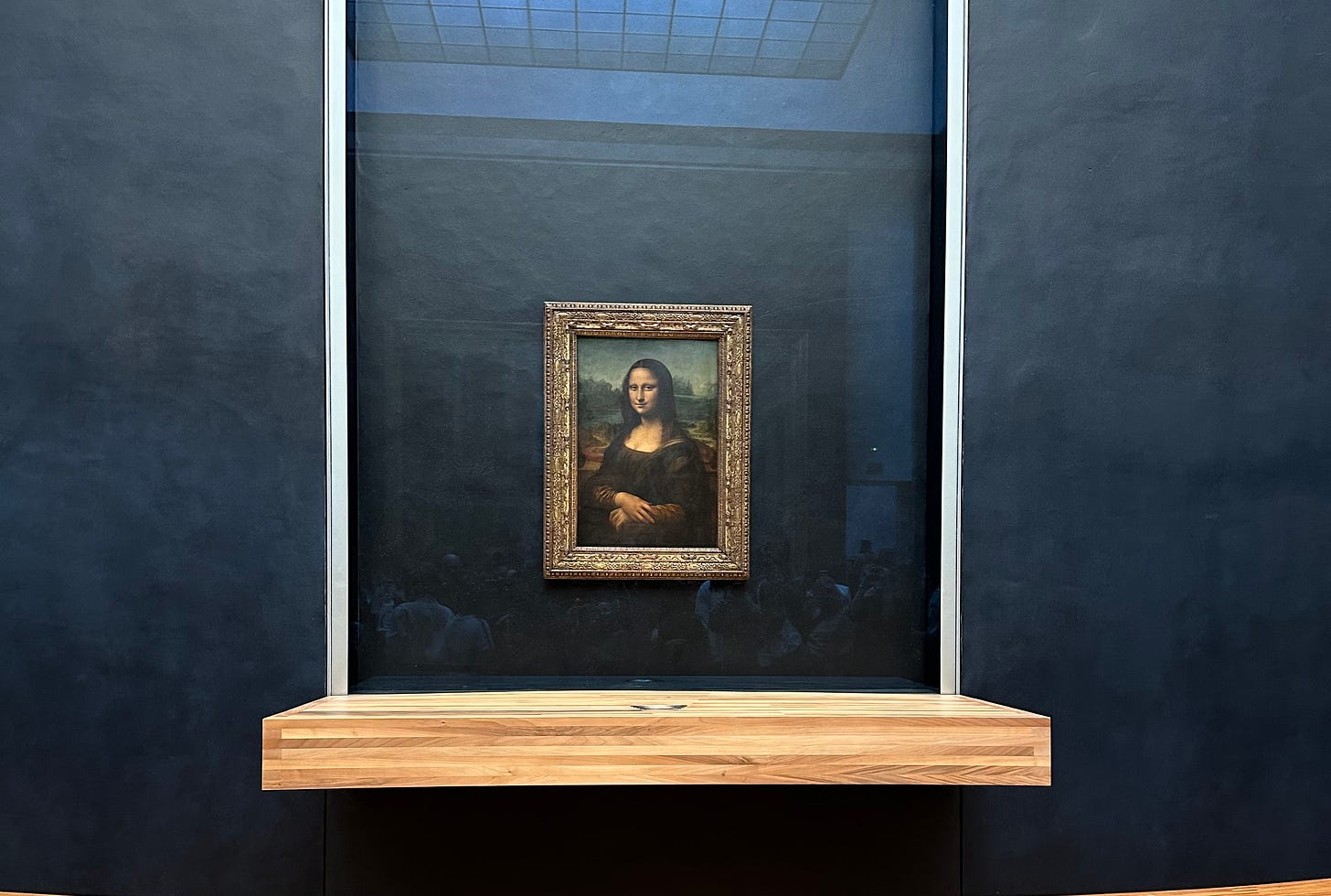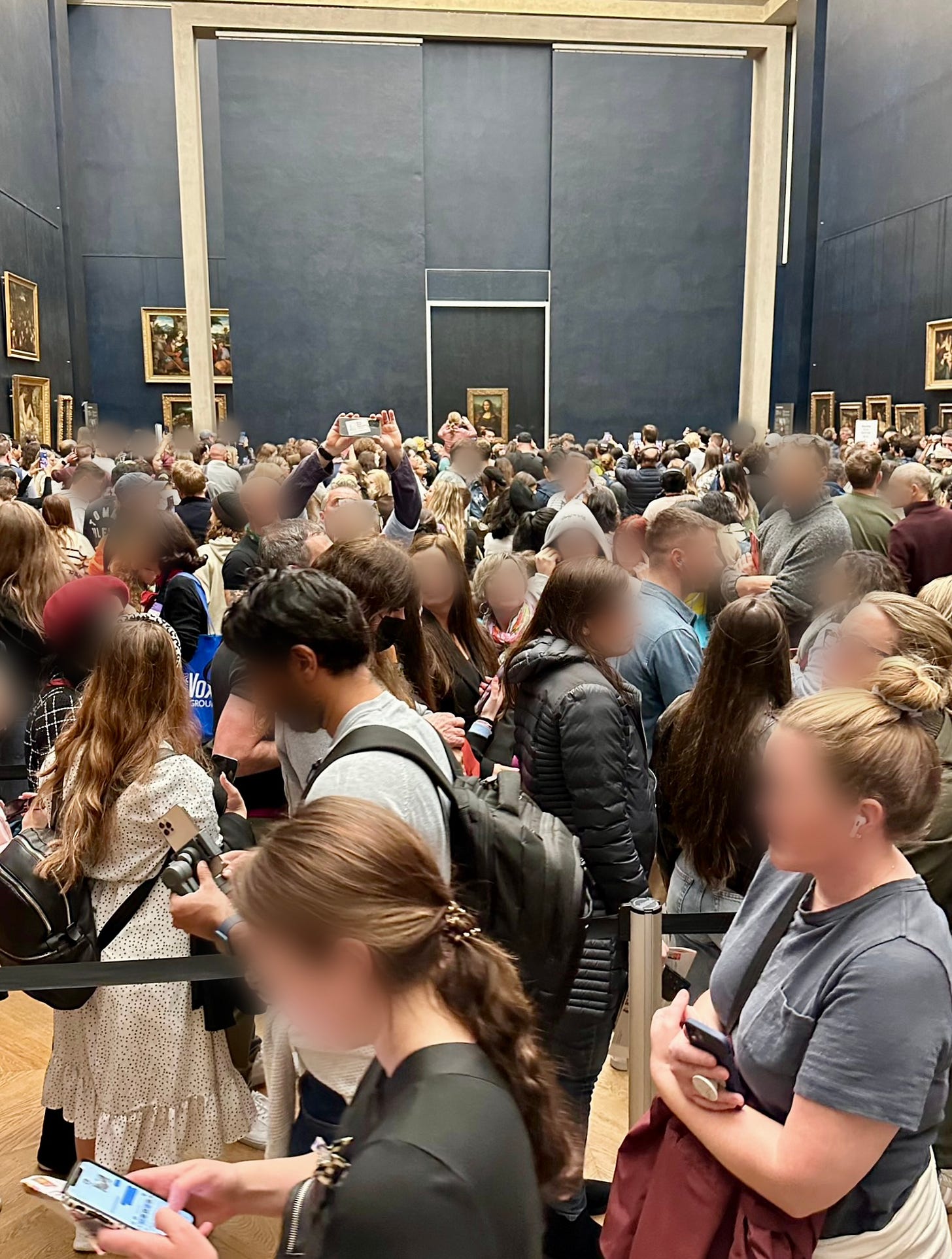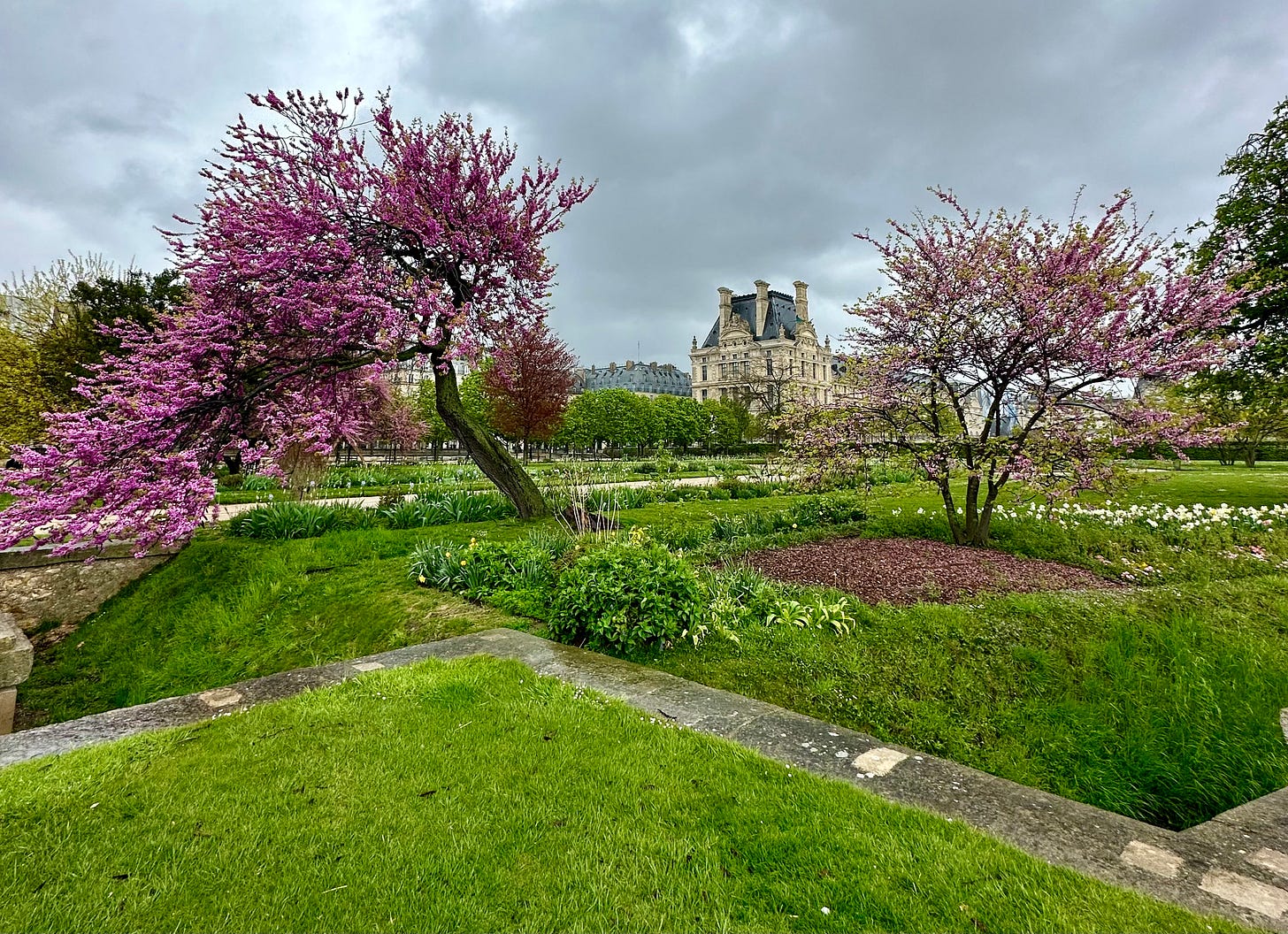It was my first time at The Louvre when my 10-year-old daughter and I lined up with hundreds of others outside the famous glass pyramid, awaiting our turn to enter. We only had two hours to visit the world-famous museum while my husband did the “playgrounds of Paris” tour with our then 4-year-old, in the pouring rain. I knew two hours would not be enough time — not by a long shot. But this was our chance to visit during a short stop on our way back to Canada from the Baltic nations. Plus, my daughter really, really, really wanted to see the Mona Lisa.
I was also intrigued by the fame of this painting, created somewhere between 1503 and 1506 by Leonardo di ser Piero da Vinci, a High Renaissance artist among many other titles: engineer, scientist, sculptor, theorist, and architect. The Mona Lisa, also known as Joconde, has a complex and fascinating history, propelled in the last century by a 1911 theft1 that made it all the more popular. Like many works in the art world that have skyrocketed to fame, the Mona Lisa’s value and popularity inflate one another in a seemingly endless cycle. I didn’t love the idea of joining the craze, but I suppose we only have one life to live. I was in France, in the Louvre; I may as well see the Mona Lisa.
My phone showed 1:30 PM, our entrance time, and with anticipation we descended the stairs into the museum. I knew from walking the exterior of the museum just how gigantic it was. The building’s enormity didn’t fully hit me until I realized it would take 20 minutes just to walk from the entrance to the Salle des États, where the Mona Lisa is displayed.
It felt rather ludicrous to be walking so hurriedly towards this particular painting, past countless classics and works of art that have also earned their place in The Louvre. We walked through a maze of exhibition halls, following our museum map closely. At one point, we thought we’d arrived only to find the room nearly empty. We retraced our steps and it was clear we had arrived in the Salle des États when all we could see was a crowd of people standing shoulder to shoulder, snaking their way towards a single focal point. I had to jump to get a glance of what lay ahead, and sure enough, there she was: the Mona Lisa.
I felt somewhat amused but mostly horrified by what was transpiring in this space. There were two queues formed like an airport security line. People, packed like sardines, inched forward, many with their smartphones raised over their heads in an attempt to capture the Mona Lisa from a distance. If you’ve not seen it before, the painting is not very big (just 30 inches by 21 inches). It is mounted at eye level, behind glass, in the middle of a large wall. Any attempts to photograph it from afar are utterly useless. Perhaps these people wanted to capture the madness in the room, not the painting (you can bet I snapped a photo of the pandemonium). But, I’m more inclined to think the painting is like any celebrity standing in the distance. Humans, myself included, have this funny and confusing obsession in associating with fame, however loosely.
“If we want to see it up close, we will spend our whole time in The Louvre standing in this line,” I said to Maya. I thought of the other masterpieces lining the halls, just a handful among the 500,000 objects housed in this, the world’s largest museum. But she was so heart-set on seeing the da Vinci; I wasn’t about to shatter her dream. So, stand we did. We shuffled along, standing uncomfortably close to people who forced me to stand face-to-armpit as they reached up for a photo. The line moved surprisingly fast, and as we got closer to the front I figured out why.
Prenez votre photo et faites place au suivant!, yelled one of the two security guards standing beside the painting. Then in English: Take your photo and leave!
The people at the front of the line had a small area, cordoned off by a rope, from which they could view the painting. But nearly everyone had a phone or camera out. There was no opportunity granted to stand and observe, to take in the subtleties the Joconde was so famous for, to understand why it was considered a masterpiece. One needed to snap a photo to have a piece of the experience to refer back to later. One apparently also needed to take a selfie.
I observed this unfolding as we inched ahead, and soon enough it was our turn. I got Maya in front of me, right behind the rope, because she was too small to see over anyone. Like everyone else, I took some quick photos. Then, even as the guard barked the orders to get out of the way, I leaned towards Maya and spoke right into her ear: “We’re going to stand here and look at her for ten seconds, no matter what is happening around us.”
It was clear that, even in her youth, Maya understood what this meant. I held her shoulders and we stood there at the very front. I felt like a shield, protecting her from the madness as people bumped up against me and pushed us into the rope. I counted back slowly from ten, and together we looked at the painting. Amidst that chaos, ten seconds felt like an eternity. Guards yelled. People took cruddy photos.
I felt like a disruptor in the best possible way.
This is not how this is meant to be, I thought to myself. It was everything toxic and unpleasant about our culture of consumerism crammed into one room in a museum in France.2
Eventually, conditions became uncomfortable enough that I nudged Maya towards the exit. We laughed like school kids as we walked away, feeling both bewildered and entertained by what had just transpired. We had just enough time to walk to another part of the museum to see the mummified Egyptians before exiting the building into the spring rain and blossoms of Paris.
I have leaned into those ten seconds many times since. I appreciate that they gave me a moment to enjoy the thing I was there to see, despite the urgency to move on quickly. But it has also come up as a mindfulness practice and the visual I’ve needed when I sense I’m speeding through life. It offers the reminder to slow down and smell the roses (or stop and stare at the world’s most famous painting). I still didn’t get a good look at the Mona Lisa that day, and photos simply don’t do it justice. But it was the act of standing there that has stuck with me. I hope it sticks with Maya, too.
I still didn’t get a good look at the Mona Lisa that day, and photos simply don’t do it justice. But it was the act of standing there that has stuck with me.
I have many opportunities each week, even each day, to take those ten seconds. I never regret it when I put down whatever it is I’m doing or thinking about, and focus on the thing right in front of me. Sometimes it’s an adorable moment with my five-year-old. Sometimes it’s a sunrise over the mountain out my window. Sometimes, it’s even more subtle than that. My “Mona Lisa 10” grants me the challenge to find beauty and detail in even the most mundane or familiar of scenes.
It’s just one more way to cultivate gratitude in my life. And, in this case, it’s double gratitude — for the thing I get to appreciate and for the time I took to slow down and see it.
Ready to dive deeper with me? Upgrade to a paid subscription.
Meghan J. Ward is an outdoor, travel and adventure writer based in Banff, Canada, a Fellow of the Royal Canadian Geographical Society, and the author of Lights to Guide Me Home. Meghan has written several books, as well as produced content for films, anthologies, blogs and some of North America’s top outdoor, fitness and adventure publications.
What’s caught my attention lately… ✨
The Science of Effective Communication with Charles Duhigg on Ten Percent Happier with Dan Harris (I link to Apple podcasts, but these can often be found wherever you listen). This episode was truly enlightening and full of practical tips to help you communicate better with those around you. I found myself wanting to put many of them to memory so that I could apply them (it’s hard while you’re in a conversation to remember them!) I look forward to committing more energy to improving these skills.
Embers: One Ojibway’s Meditations by Richard Wagamese has been a delightful read lately. I don’t know how I hadn’t heard of it before; I’ve previously enjoyed Wagamese’s other writings. This book has joined my collection of morning reads when I have only 10-15 minutes to sit in the quiet before sunrise. It’s designed to be read in bite-sized pieces, and I often find myself journalling about what comes up.
Check these out too… 🙌
Lights to Guide Me Home - my memoir (reviews welcome on Amazon and Goodreads)
The Wonders That I Find - my children’s book
My Email Newsletter - updates about my books, projects, and 1:1 coaching
I am an eight-generation Canadian and a descendent of British, Scottish and German settlers living, working, and recreating outdoors in Treaty 7 Territory — the homelands and gathering place for the Niitsitapi from the Blackfoot Confederacy, including the Siksika, Kainai, and Piikani First Nations; the Îyârhe Nakoda of the Chiniki, Bearspaw, and Goodstoney First Nations; the Tsuut’ina First Nation; the Métis Nation of Alberta, Region III and many others. I am doing my utmost, both personally and professionally, to deepen my understanding of the history of Indigenous peoples and the impacts of colonialism — past and present.
In 1911, the Mona Lisa was famously stolen from the Louvre Museum in Paris by three Italians led by a handyman named Vincenzo Perugia, who attributed his actions to patriotism and the belief that the painting belonged to Italy. Prior to this, the Mona Lisa was not widely known outside the art world. Its theft and recovery in 1914 sparked a media frenzy and worldwide fascination, which catapulted the painting to greater fame.
According to Smithsonian Magazine, “It’s been behind glass since a visitor poured acid on it in the 1950s, damaging the frame, per CNN. In 2009, a woman threw a ceramic cup at the work, and two years ago, a man smeared cake onto the glass.”
More recently, in January 2024, climate activists threw soup at the painting. Before they were led away by security, they exclaimed, “What is more important? Art or the right to have a healthy and sustainable food system?”
It seems the intrigue with this painting won’t die out any time soon.
A dinnertime conversation about this last night had my husband and I discussing the general trends of social media in a similar vein. I could just as easily have used this series of events as a metaphor for the ways we consume media, and what is lost amongst the trends and this notion of “virality.”








I enjoyed the scene and reflection upon that moment. At the footnote, I became curious about another piece that you might write about how 'virality' has taken over travel and seeing. One of the ways I like to see art or nature is to go in devotion to one particular work or being, to sit with it. How remarkable to do this in ten seconds.
This is so beautiful, Meg. What a deep, gorgeous, profound, essential, wise example to set for your daughter, while bonding over this once in a lifetime experience. I will take 10 seconds today to stare at something beautiful. Thank you.